I’ve mentioned this plant a few times, but I don’t think I’ve ever really written up this interesting little shrub, Cordia globosa; the common name is bloodberry. It has many virtues to recommend it: it’s easy to grow, easy to maintain, and attractive to a wide variety of nectaring insects and berry-hungry birds. The flowers aren’t particularly showy, but they are abundant, and when the plant fruits, the little red berries make a nice display. I have one growing in my front “courtyard”; here’s a picture of the tiny little flower:
The flowers aren’t normally borne singly; I just wanted to show one flower head without the old brown flowers cluttering it up. Here is what the marble-sized flower head on a short stem (peduncle, when it supports an inflorescence, as these do) looks like normally, with a few new white flowers and a few old brown ones. I also like the intricate pattern of “dots” (papillae; when hairy, “papillose-hispid”) on the coarsely serrate leaves:
The flowers are quite small, which is very nice for the smaller butterflies like the Cassius Blue or the Mallow Scrub-Hairstreak, which are tiny little guys that can’t extend their proboscis into the deeper flowers. And the berries are so abundant that the giant plant at my old house provoked several families of mockingbirds into weeks’-long squabbles over possession of it. Here’s a little shot of that large old plant (and less than a year in the ground at that; it eventually grew to about twice this size):
According to Rufino (we native plant enthusiasts say that the way a previous generation of card players would say “According to Hoyle,” at least here in Palm Beach County), it can be trimmed to nearly any desired height or shape. I didn’t find this to be the case with the large plant I had on the side of the old house; when I trimmed it back from the a/c unit, it never regained its former vigor.
The IRCS website notes that it is listed as endangered by the state of Florida, and imperiled in the Florida Keys. It’s readily available in the native plant trade, though.
I’m hoping to get numerous seedling of this baby and plant them as a hedge in the front yard. I’ve got several firebushes and cocoplums in the propagation station, but nothing looks super vigorous, and I know firsthand how fast this bloodberry plant can grow.
The name is a bit of a puzzler: cordialis in Latin is hearty, cordial, but that doesn’t help us at all. In fact, cordia is actually an eponym. The genus was named after the 16th-century German botanist Valerius Cordus. Globosa is, well, globular (spherical, really), as in globular cluster. The plant is usually written up as Cordia globosa (Jacq.) Kunth HBK., which might lead one to believe that this is another of the plants described by the short-lived French botanist, Victor Jacquemont. Another one is the vine in my back yard, Jacquemontia pentanthos. However, this is not the case, because Victor Jacquemont was born in 1801, and no matter how precocious he was, I don’t think he was getting published before birth. No, this plant was described in 1760 as Varronia globosa by Nicolas Josef Freiherr von Jacquin in his ponderously titled, pre-Linnaean botanical prodromus, Enumeratio Systematica Plantarum, quas In Insules Caraibes vicinaque Americes continente detexit novas, aut jam cognitas emendavit).
Here are the two pages where it is mentioned by Jacquin; first the “genus” page:
and then the “species” page:
The taxon was later revised by Kunth in Humboldt et al., Nov. Gen. Sp. 3: 76. 1818, and we know it today as good old Cordia globosa:
The one in my front courtyard certainly appears vigorous; here is what it looked like back in late April, shortly after being put in the ground; you can see it’s barely taller than the baby Salvia in front of it:
And here it is almost exactly three months later (the plant on the right); it’s nearly four feet tall already, and preparing to dominate the scene:
It looks even bigger because it’s placed right next to the diminutive Heliotropium polyphyllum, which is a fine flower in its own right, but will not grow about 12 inches high at best. That’s a mistake I’ll not repeat.
I’m waiting rather impatiently for this plant to fruit, so I can collect the babies and put them out front as a border hedge along the front sidewalk. (My neighbors are probably waiting slightly less patiently, as the bare patch in the front yard is rather unsightly at the moment!)


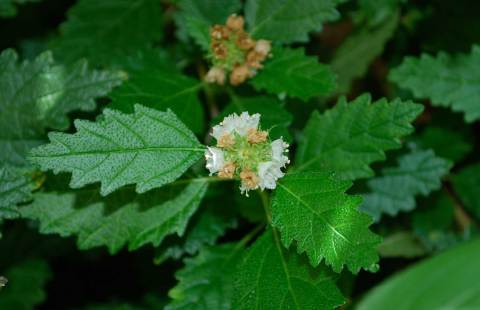

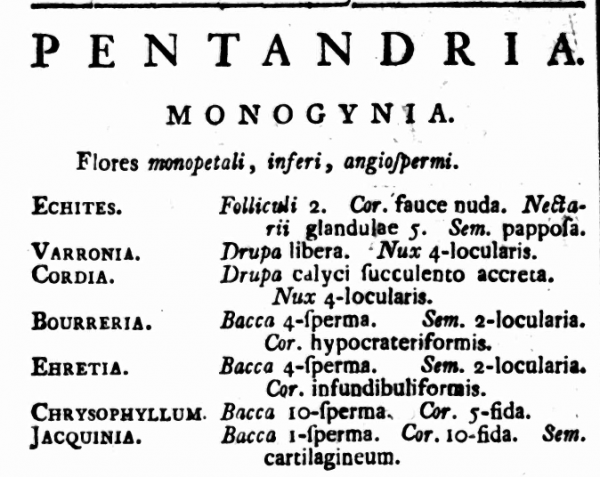
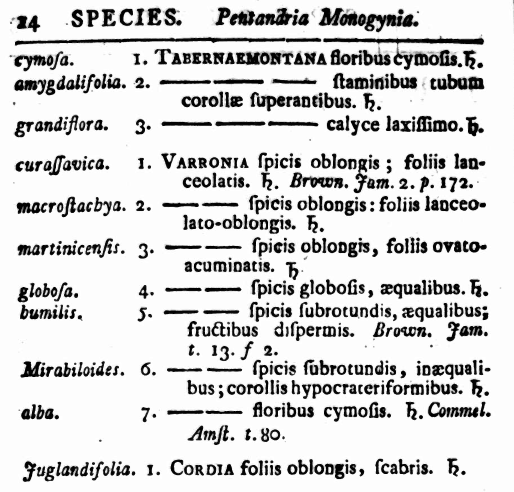
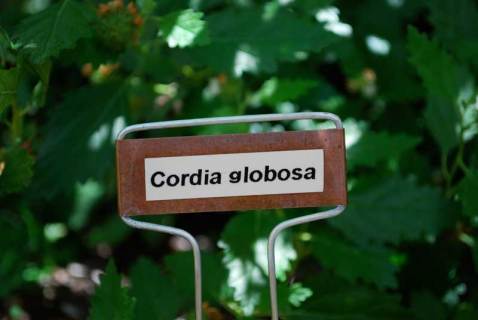
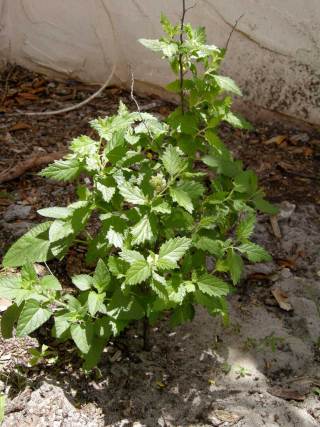

Very Very nice article! Thank You! I just bought one and I’m excited to plant it after reading Your write up!
This is indeed a very nice article. I live in the Cayman Islands where it’s status is also uncommon. It will root in 5 weeks in a mist bed, the birds eat the seeds before I can get to them. It is suitable as landscaping material in soil or sand, part shade or full sun, it is also drought and salt tolerant, it will bloom all the time and butterflies like it too. the foliage are interesting mix.
I find that it is a good plant for hedging because it can easily be trimmed and grows fast.
This is an under use native that needs to be propagated in multiples.
Joanne
Thanks for sharing, Joanne.
I love how this plant performs in the garden, bringing in all kinds of butterflies (large and small). The one thing I dislike is when I need to prune it, the leaves are quite scratchy. Apart from that, it’s “perfect in every way.” Glad to know more about this plant in the wider tropics.
Cheers!
The plant is also found in the Bahamas with a varietal form humilis (Jacq.) L.M. Johnst., having smaller leaves with marginal teeth obtuse rather than acute. It’s distribution is listed as Florida, Mexico, Central America, throughout the West Indies, to northern South America; found in open woods, or fence rows, no common name (Correll and Correll 1982, p. 1198), but I have seen it in sandy soil along the shore on San Salvador Island. Proctor (2012, p. 570, plate 55) also lists the Cayman Islands variety, humilis, common name black sage.
Current accepted name according to the TROPICOS website is Varronia globosa Jacq.
Reference article Davidse, G., M. Sousa Sánchez, S. Knapp & F. Chiang Cabrera. 2012. Rubiaceae a Verbenaceae. 4(2): i–xvi, 1–533. In G. Davidse, M. Sousa Sánchez, S. Knapp & F. Chiang Cabrera (eds.) Fl. Mesoamer.. Missouri Botanical Garden Press, St. Louis.
LBK 18 Oct. 2015
Thanks for the information, Lee! As I understand it Cordia is a junior synonym, so it should indeed be Varronia. The Atlas of Florida Vascular Plants still lists it as Cordia, though, so I guess I can cop out and say that I follow their taxonomy. But since I’m not even a taxonomist, that would be a bald-faced lie!
This is also called worm bush and Sir John is Jamaica. It’s used as a tea for intestinal problems.